|
|

War of Independence |

|
|
The Battle for the Roads
|
| A unique feature characterizing the first phase of the War of Independence up to May (1948) was the "battle for the roads." The vast majority of Palestine's main roads ran through areas populated by Arabs, and by controlling the roads, the Arabs could effectively lay siege to areas of Jewish settlement. In March, having failed to capture Jewish settlements, the Arab forces concentrated on the battle for the roads, while continuing their attacks on outlying districts in the mixed towns and on settlements in the north, the Jerusalem mountains, and the Negev. Nevertheless, a convoy of armored trucks succeeded in making the trip from Negbah to Gat, which had been cut off for a long period, and an Arab arms convoy was ambushed and destroyed near Kiryat Motzkin. In general, the Arabs scored considerable success in the battle for the roads: on March 26 Jewish traffic on the coastal road leading to the Negev came to a complete stop; a convoy on its way back to Jerusalem from the Ezyon bloc was trapped near al-Nabi Daniyal and another, which tried to reach Yehiam, was ambushed and wiped out. |
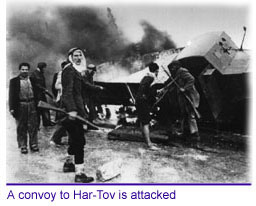
|
Throughout this period, however, the Jewish defense forces made substantial progress in organization and training. By the end of March, 21,000 men aged 17-25 were under arms. The manufacture of antitank projectiles, submachine guns, and explosives was greatly stepped up, and large quantities of light arms, purchased in Czechoslovakia, were expected to arrive. The yishuv's air force consisted of 30 light planes for reconaissance, transportation, and supply to isolated areas. The Arab forces-both the locally organized National Guard and the volunteers from the Arab states - were also growing. |
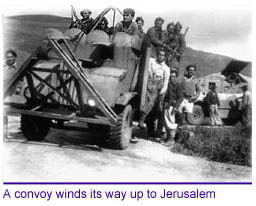
|
|
Operation "Nachshon"
|
| With the British about to leave, it became imperative for the Jews to gain control of the territory that had been assigned to the Jewish State. Such a move would enable the Jews to have a foothold when the Arabs would invade.
To this end, an operational plan ("Plan D") was devised. This plan would be carried out in stages which would be adapted to the manner and rate of the British troop withdrawal.
The first objective of Plan D was to open the road to Jerusalem, to this end Operation Nachshon was devised. The name "Operation Nachshon" was derived from the biblical personage Nachshon Ben Aminadav who was the first to jump into the Red Sea when the Jews fled Egypt. . Operation Nachshon was a first in many respects. It was the first major Hagana operation and it was the first time that a "brigade force" was employed. Before this the Hagana had operated in company-size only. The brigade force, comprised of three battalions and numbering 1,500 men, was and specifically organized for this operation. These men were armed with Czech weapons that had been smuggled into the country on April 1 at a hidden airstrip in the south. These weapons were covertly issued to Hagana members who were desperate for arms. |
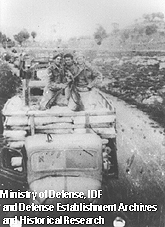
|
| Two significant operations preceded Operation Nachshon: the first took place in Ramle. The Hagana blew up the headquarters of Hassan Salame (the commander of the Mufti's Army of Salvation). This attack prevented Salame's forces from thwarting Hagana preparations on the coastal plain. In the second operation, Hagana forces took over the village of Castel, an Arab village which stood between Jerusalem and Kyriat Anavim and blocked the entrance to Jerusalem.
Operation Nachshon itself began on April 6 in the Latrun area with Hagana forces taking over the Wadi al-Sarrar camp, Arab Hulda and Deir Muheisin. Parallel to this, the village of Beit Machsir in the region of Bab el Wad was attacked by Palmach forces, thus clearing the mountain road to Jerusalem. Sixty Palmach trucks drove up to Jerusalem carrying supplies. On 7 and 8 April Arab forces undertook reprisal operations, primarily in the area of Motza. The battle for Castel was fierce. For six days the Arab and Jewish forces battled fiercely. The Jewish forces were pushed back.
In a dramatic reverse, Abd el Kader el-Husseini, who had returned from Damascus to fight, was killed in battle. This proved to be the undoing of the Arab forces on April 10 immediately thereafter retreated. Supplies could now reach Jerusalem safely and by April 20, five convoys of reserves and additional troops reached the city. This condition however, lasted only a short period of time. Immediately thereafter supplies could no longer easily reach the city and convoys had to turn back, as the road to Jerusalem became impassable once again. This precipitated the siege of Jerusalem. |
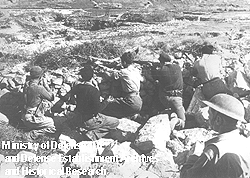
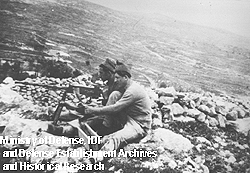
|
|
The Capture of Tiberias
|
| The capture of Tiberias and the opening of the roads leading to the eastern the Galilee made it possible to reinforce the Haganah troops in the northern tip of the country. On April 18, troops of the Golani area command and the Palmach cut in two the Arab part of Tiberias, where the Jewish quarter was under heavy attack. The Arabs decided to leave the town and were evacuated with British aid. On April 21, when the British started to concentrate the remainder of their forces in the Haifa port area, the battle for Haifa began. The Jewish forces captured it within 24 hours and most of the Arab inhabitants left, despite Jewish assurances that no harm would befall them if |
|
Operation "Yiftach"
|
| On April 30, Operation "Yiftach" was launched to capture the strategically-important town of Safed in Galilee. On the eve of the British withdrawal from Safed on 15 April, the Palmach had infiltrated into Safed, bolstering the defenses of the besieged Jewish quarter. With the withdrawal of British forces, the Arabs had managed to take control of strategically advantageous points in the city, including: a police fortress on Mount Cana'an, an ancient fortress in the town and an additional strategically-located building, Shalva House. On April 28, Hagana forces occupied the Rosh Pinah police fortress and a neighboring army camp as soon as these were evacuated by the British. Circumventing Mount Cana'an, Palmach forces occupied the villages of Birya and Ein Zeitun to the North of Safed and from here opened a corridor leading into the Jewish quarter of Safed through which the supplies were brought by soldiers into the starving quarter. On May 3, a second Palmach unit entered Safed, but the first Jewish attack, on May 6, ended in failure; the Arabs brought in reinforcements and began using artillery. A new attack, on May 10, resulted in the capture of the key positions in the town. The Safed Arabs, numbering some 10,000 fled the town, despite Jewish assurances thay would not be harmed. This enabled the Jewish Forces to take control of a continuous area in eastern and Upper Galilee. |
|
|
Operation Hamez
|
| For some time Arab villages east of Jaffa had been threatening the road to Jerusalem and created a wedge between the Jewish areas to the north-east and south-east of Tel Aviv. Arab attacks were being mounted constantly on the outlying areas of Tel Aviv, and snipers from Jaffa's high buildings covered the main thoroughfares inside Tel Aviv, so that innocent passers-by could be picked off. In the Tel Aviv area, the Alexandroni Brigade commanded by Dan Even along with forces from the Kiryati and Givati brigades launched Operation Hamez (Leaven) on the eve of Passover. The aim of the operation was to capture the Arab villages east of Jaffa: Hiriya, Sakiya, Salame, and Yazur. The Jews did not originally plan to capture Jaffa, rather their aim was to use an indirect approach to encircle the number of Arab villages east of it which endangered the road to Jerusalem. As long as the threat of the Arab Armies was minimal, the Hagana forces refrained from attacking Jaffa. The encirclement of Jaffa was completed on April 29, and most of its 70,000 Arabs inhabitants fled. Its final surrender came on May 13, when the British troops left. On May 14th, the Beit Dajon police station was captured, thus opening the road to Ramlah and the South. |
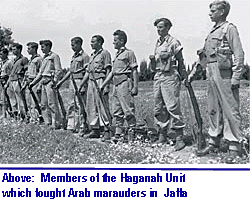
|
|
May 15 : Arab Armies Invade
|
| On May 15, 1948, the day the British Mandate over Palestine ended, the armies of five neighboring Arab states invaded the new State of Israel, which had declared its independence the previous day. The invasion, heralded by an Egyptian air attack on Tel Aviv, was vigorously resisted. From the north, east and south came the armies of Lebanon, Syria, Iraq, Transjordan, and Egypt. The invading forces were fully equipped with the standard weapons of a regular army of the time - artillery, tanks, armored cars and personnel carriers, in addition to machine guns, mortars and the usual small arms in great quantities, and full supplies of ammunition, oil, and gasoline. Further, Egypt, Iraq, and Syria had air forces. As sovereign states, they had no difficulty (as had the pre-state Jewish defense force) in securing whatever armaments they needed through normal channels from Britain and other friendly powers. In contrast, the Jews had no matching artillery, no tanks, and no warplanes in the first days of the war. Some supplies of these weapons arrived in the days that followed, however, and turned the tide. Little more than small arms - in paucity- had been available to the Haganah which on May 28, 1948 was to merge with other Jewish defense groups to form the Israel Defense Forces. Two Jewish defense forces, the Irgun Zeva'i Le'ummi and the Lohamei Herut Israel agreed to cease their independent activities, (except in Jerusalem) and to absorb their members into the newly founded IDF. Invaded from all directions, Israel had to cope with the outbreak of a thousand fires, and to do so with limited means. Numerous settlement outposts in the Galilee and the Negev were isolated, open on all sides to Arab attack, and had to rely on their own perseverance and meager armories to stave off defeat. The hastily mobilized army had to engage in offensive action to remove the enemy from key positions, block the advance of their columns, and rush to seal gaps in Israel's defenses. |
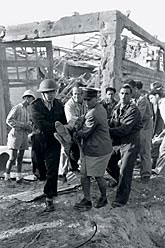
|
|
The Negev and The South
|
|
Invasion of the Egyptian Army - May 1948
|
|
|
15 May: The Struggle in the Negev
|
|
| In the early morning hours of May 15, 1948, Egyptian forces crossed the international border separating Israel and Egypt, and advanced in two columns: one North along the coastal Road and the other South-east towards Beer Sheba.
On the night of May 14-15, the Egyptians attempted once again to conquer Kfar Darom, a religious kibbutz 7 miles (11 km) south of Gaza. A previous Egyptian attack on May 10th was repelled, after several assault attempts had been beaten back by the defenders. In one such attempt defenders who lacked grenades filled their phylacteries (tfillin) bags with TNT and threw them at the Egyptian troops. Reinforcements sent to support the defenders ran into an Egyptian force which prevented their arrival to the kibbutz. The Kfar Darom defenders, however, succeeded in pushing back the attackers who avoided launching additional attacks on the kibbutz. |
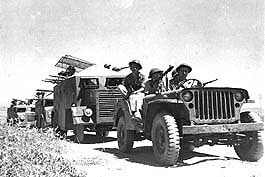
|
| At the same time that Kfar Darom was attacked, Syrian forces attacked Kibbutz Nirim, further south. However, Israeli forces succeeded in repelling the attackers and in inflicting heavy casualties on them. As a result of this failure, the Egyptians came to the realization that any attack launched on the Jewish forces would exhaust their troops. The Egyptians continued their advance, and headed towards Tel Aviv, and reached Kibbutz Yad Mordechai, which was situated on the main road to Tel Aviv. |
|
|
19 May: Attack on Yad Mordechai
|
|
| The need to concentrate large-scale forces caused the Egyptians to delay their May 19th attack on kibbutz Yad Mordechai. Egyptian forces included two infantry battalions, one armored battalion and one artillery regiment. The attack began with an artillery softening-up. After three hours of hard fighting, the Egyptians forces managed to infiltrate into the farm yard. In bitter hand-to-hand fighting, the defenders, who together with reinforcements from the Negev Brigade numbered no more than a company, succeeded in repelling the attackers. The attack was renewed the following day. That same day, the defenders of the settlement managed to repel four Egyptian attacks, one after the other. On May 22 1948, the Yad Mordechai defenders informed the Southern Command Staff that: "The strength of our fighters is weakening, the forces are exhausted. We fear that Yad Mordechai will fall as did Kfar Etzion. Either evacuate the kibbutz or dispatch support. It is imperative that the women and wounded be evacuated immediately." |
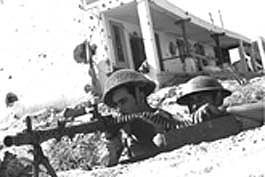
|
| Following a number of additional Egyptian attacks, the Southern Command Staff decided to withdraw. With morning twilight on the 24th of May, Yad Mordechai kibbutz members withdrew kibbutz Gevaram. The conquest of Yad Mordechai cost the Egyptian forces approximately 400 losses. In addition, during the five days that it took the Egyptians to capture Yad Mordechai, Israeli forces were able to build a defense line North of Ashdod. |
|
| The fall of Yad Mordechai opened up to the interior of Israel to the Egyptian forces. The "Givati" Brigade had taken part in the fighting around the Jerusalem "corridor." The Brigade returned to the South the day following the Egyptian invasion. Two days later, the Brigade launched an operation to mop-up the sector. The Sarafand (Tserifin) camp was captured on the night between the 19th and 20th of May.
In the afternoon hours of May 21, 1948 kibbutz Negbah was attacked by an Egyptian armored column and strafed from the air. |
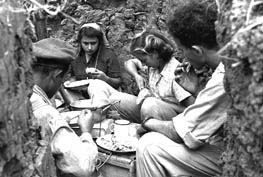 |
|
The Battle for Degania
|
| The Syrian attack on Degania A and Degania B began at dawn of 20 May 1948. The main objectives of the Syrian advance were the Jordan river bridges north of Degania A. After shelling the center of kibbutz by mortars and tank guns which continued even during the fights. An integrated Syrian force comprised of tanks, armored cars and infantry attacked the defense position at the outer perimeter of Degania A. They forced the defenders, 70 in number, out of their positions and into the communication trenches. Some of the Syrian tanks and armored vehicles were able to advance close to and eventually penetrate the kibbutz fence. But they were stopped by 20 mm cannons, Piat antitank shells and Molotov cocktails. One Renault 35 tank which penetrated into the kibbutz was attacked by Molotov cocktails and hand grenades . It remains in the kibbutz till today as a monument.
Syrian infantry troops who approached the kibbutz perimeters were stopped by the defenders.
During the attack, Syrian artillery isolated the routes thus preventing reinforcements from arriving.
The defenders' positions were hit and the defenders suffered casualties.
Yet despite their losses and lack of appropriate weapons and ammunition, the defenders were able to hold their positions and the Syrians retreated after several of their armored vehicles were hit.
With the battle for Degania A over, the Syrians attacked Degania B. Shelling the kibbutz with mortar bombs as tanks and armored cars approached the kibbutz. This time the tanks stopped at a safe distance of 400 meters from the fence and shelled the defenders' positions.
Syrian infantry that attempted to approach the troops were driven back. A second assault by infantry and armored vehicles was also repelled. At this time new field artillery pieces arrived . They were thrown into action before their crews had the time to train with them. However the artillery barrages caused surprise and confusion among the Syrian troops who began to withdraw.
The battle ended with the Syrian retreat. Israeli forces captured the village of Zemah, North-East of Degania. |
|
The Founding of the
Israel Defense Forces - 28 May 1948
|
| The existence of armed forces responsible to the elected government of a nation is one of the hallmarks of a democratic nation-state. Before the establishment of the State of Israel, a number of armed Jewish defense organizations operated. In addition to the Haganah and Palmach, which answered to the elected leadership of the Jewish national institutions, other armed defense groups, namely the Lehi (Lohamei Herut Israel or 'fighters for the Freedom of Israel') and the IZL (Irgun Zevai Le'ummi or 'National Military Organization') operated independently. It was only natural that when the independence of the State of Israel was declared the new, legal Government would decide to establish a single, unified armed force loyal to the Government of the State of Israel: The Israel Defense Forces.
On 28 May 1948, the Provisional Government of the State of Israel issued Defence Army of Israel Ordinance No. 4. This ordinance, signed by Prime Minister David Ben-Gurion, established the Israel Defense Forces, which would be comprised of "land forces, a navy and an air force". The ordinance was published in the Official Gazette No.3 of 31 May 1948.
In a state of emergency, conscription would be instituted and the age for conscripts would be set by the Provisional Government. The existence or establishment of any armed force other than the Israel Defense Forces was prohibited. Every individual serving in the IDF would be required to swear allegiance to the State of Israel, to its laws, and its legal bodies.
The general officers of the nascent Israel Defense Forces were sworn-in in a ceremony conducted on 27 June 1948.
The process of establishing a unified Israel Defense Forces was protracted. It began in the midst of the fighting against invading Arab armies. The Lehi resistance organization dissolved itself immediately upon the creation of the State of Israel and its members joined the IDF on an individual basis. However, in the Jerusalem area, the Lehi continued to function as an armed fighting force until 17 September 1948 when the organization in that sector was dissolved according to a government order issued after the assassination of the UN mediator Count Folke Bernadotte.
Individual battalions of the IZL joined the IDF with the exception of those fighting in Jerusalem. However, following the Altalena incident, these battalions were disbanded on 20 September 1948, and their soldiers joined the IDF on an individual basis as did all other citizens of the State of Israel.
The companies and battalions of the Palmach joined the IDF in a process which extended until the Chief of Staff ordered the dissolution of the Palmach on 29 October 1948, which became effective on 7th of November.
The creation of a unified IDF lasted almost 6 and a half months, from 28th of May 1948 till 7 November 1948. |
|
For the official translation of the ordinance which was published in the Official Gazette No. 3 of the 22nd Iyar, 5708 (31st May, 1948)
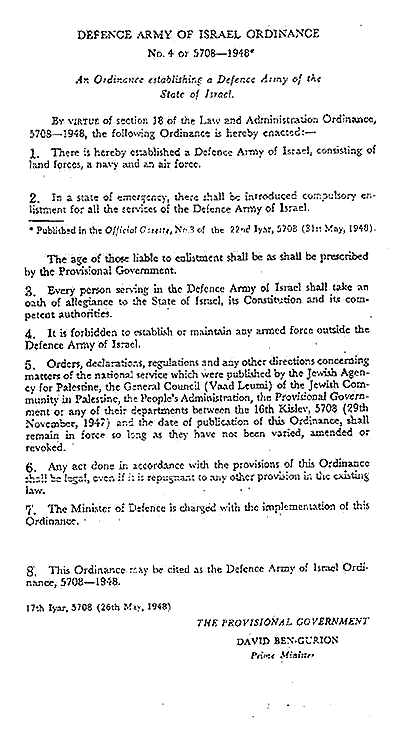
|
|
For the original Hebrew document signed by David Ben-Gurion
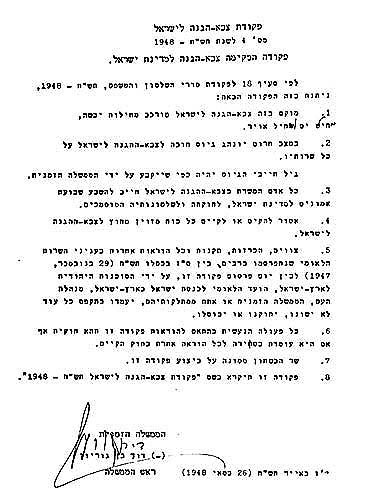
|
|
|
The First IAF Fighter Mission - Stopping An Egyptian Column Near Ashdod
|
|
29 May: Egyptian Column Halted Near Ashdod
|
|
| On 29 May 1948, an Egyptian column, numbering some 500 armored vehicles and cannons, crossed Kibbutz Nitzanim on its way up northward. The Egyptian column advanced toward Ashdod. If the Egyptian force would not be halted at Ashdod, it would be able to continue its advance to Tel Aviv. Therefore, the IDF General Staff decided to strike hard at the advancing column and employ aircraft for the first time. With little to defend itself in May '48, Israel hurriedly purchased a number of second rate Czech-made Messerschmitts. The planes were taken apart, transported to Israel at night, and secretly reassembled at Ekron (later to become Tel Nof AFB). The first pilots hoped to employ this force against the main Egyptian air threat based at El Arish. Yet fate had other plans for them. |
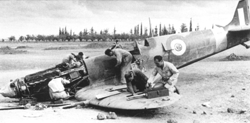
|
| An Egyptian column of some 500 vehicles was making its way up the Coastal Road towards Tel Aviv. The column halted briefly at a bombed-out bridge near Ashdod. Barely 20 miles separated the enemy from its objective. With no alternative, the first four fully assembled planes were pressed into action. Lou Lenart, an experienced American volunteer, was selected to lead the historic mission. He was joined by Moddy Alon, Ezer Weizmann and Eddie Cohen. Each plane swooped down on the enemy with two 70-kg bombs. They continued to strafe the column despite the heavy ground fire. Unfortunately, the Messerschmitts' untested 20 mm cannons and machine guns jammed quickly and the few rounds that they fired didn't inflict much damage. But the psychological effect was enormous. The surprised Egyptians scattered for cover in the face of a bona fide aerial attack. By the time they regrouped, they had lost the offensive. Israel's outnumbered Givati forces seized the opportunity to launch a counterattack and stopped the advance in its tracks. The bombed-out bridge later became known as Gesher Ad Halom (Until Here). The price of success was high: Eddie Cohen, a South African-born pilot, was killed when his Messerschmitt crashed and burned. As a result, the First Fighter Squadron lost one-fourth of its pilots on its maiden combat sortie. This was to set the tone for the future: achieving the mission despite personal sacrifice. |
|
|
11 June: Disconnecting the Negev
|
|
| Since the Egyptians forfeited their advance northward, they devoted all their efforts to securing their rear lines and arteries of transportation. On 7 June, the Egyptians attacked kibbutz Nitzanim, located south of Ashdod. The first attempt to break through was repelled by the kibbutz defenders. After extensive fighting, and after taken heavy losses, the 150 Nitzanim defenders were forced to surrender. In the battle for Nitzanim, the Egyptians managed to capture Hill 69, a key position controlling the road to the Ashdod area, and the Egyptians endeavored to sweep on towards Beer Tuvia. But here the defenders stood firm. The main Egyptian objective now was to cut off the Negev completely from the north and to lend added emphasis to the eastern Egyptian push via Hebron and Bethlehem towards Jerusalem. Accordingly, the Majdal-Faluja-Beit road became vitally important as a lateral axis- it would both seal off the Negev from the north and enable the Egyptian forces to reinforce their eastern effort on the Beersheba-Hebron-Jerusalem road. On the eve of the cease-fire (the night of 10-11 June) the "Givati" Brigade achieved a number of tactical victories and succeeded in cutting off the Egyptian "desert road" from 'Uja to Beersheba. |
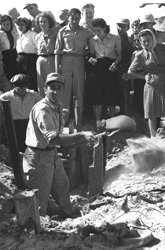
|
|
The First Truce
|
| The first truce (11 June - 9 July), was supervised by Count Folke Bernadotte, (the UN mediator for Palestine who had been appointed by the UN General Assembly on May 21), together with teams of UN observers made up of army officers from Belgium, France, Sweden, and the United States. It was to last 28 days, and the observers were to ensure that no side would gain military advantage during this period by purchasing additional weapons. However, both sides succeeded in bypassing the limitations imposed on them by the truce and used the time to improve their positions. The IDF took advantage of this time to reorganize the army, give basic and more rigorous training to its men as materiel arrived from Europe (particularly Czechoslovakia). Towards the end of the truce period, it became clear that the truce would not be extended. At the end of the truce Count Bernadotte presented a plan according to which the Galilee would be given to the Israelis and the Negev to the Arabs, with Jerusalem remaining under UN authority. Both sides rejected this plan, and began to prepare themselves for the inevitable clash that would come on the conclusion of the truce, which ended on Friday 9 July. As this date drew closer, the IDF planned to take the offensive. Hostilities resumed and lasted ten days followed by a second truce. |
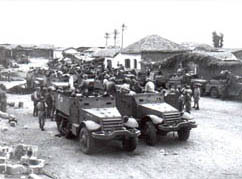
|
|
"The Ten Days"
|
|
Operation Danny
|
|
| The IDF's greatest offensive effort during the ten days of fighting was directed against the Arab Legion on the central front, the area between Tel Aviv and Jerusalem. The aim of this operation was to relieve Jerusalem and remove the threat to Tel Aviv. The first phase was to occupy the areas of Lod and Ramle; while the second phase called for the capture of Latrun and Ramallah with the intention of raising the siege on Jerusalem. The operation was to be carried out under Palmach command, utilizing a task force comprised of the Yiftach Brigade, the new 8th Armored Brigade ( made up of a tank battalion, a commando battalion of jeeps and half-tracks), and two battalions from the Kiryati and Alexandroni Brigades, as well as additional artillery and engineering units.
Two forces struck in a pincer movement, one advancing towards Lod and Ramle from the northwest, the other from the southwest. During this advance, a small force detached itself to capture al-Safiriyya and then pushed on to capture the Lod (Lydda) airport. Thus, within a day and a half, the largest airport in the Middle East and a dozen key villages had fallen to the IDF. On July 12, Kiryati units took Ramle, which surrendered after a brief engagement. North of this sector, Rosh ha-Ayin, which had been seized by the Iraqis in June, was recaptured. |
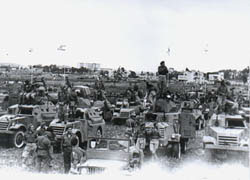
|
|
Operation Dekel
|
|
| The greatest offensive in the north during the ten days of fighting was "Operation Dekel," whose objective was to capture of Nazareth. This effort was carried out by the 7th Brigade and a battalion from the Carmeli Brigade, along with some elements from Golani Brigade. Following the capture of numerous Arab positions between the coast and the foothills southeast of Acre, the force successfully attacked Shefaram on 14 July and pressed on southeast to take Zippori the following day, after stubborn fighting. When the force was less than a mile away from the city of Nazareth, the commander of Nazareth sent out an armored car unit to block its advance. The brigade column advanced without pausing as it fired. The city surrendered on the eve of 16 July. Qawuqji himself, together with the bulk of his forces, succeeded in escaping into the mountains to the north through routes that IDF troops had not yet had a chance to seal. The result of "Operation Dekel" was to free the entire belt of Lower Galilee from Haifa Bay to Lake Kinneret. |
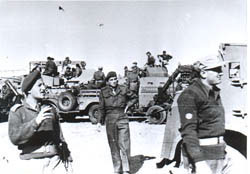
|
|
The Second Truce
|
|
| The second truce went into effect on 18 July at exactly 1900 hours. As in the first truce, violations from both sides were being made already on the day of its commencement. The Arab Legion, for example intensified its bombardment of the New City and continued to do so well into the months of July, August, September and October. The city of Jerusalem suffered extensive damage as a result of the shelling, mortaring and machine-gun fire it fell victim to almost nightly. On 12 August, the Legion demolished the Latrun pumping station, despite the fact that it was under UN control. In response, Israel speedily laid a pipeline along the Burma Road which served to keep Jerusalem supplied with water. The attacks stopped only on November 30, when both sides agreed to a "sincere cease-fire." |
|
|
Southern Front
|
|
October 15-22: Operation "Yoav"
|
|
| Ignoring the provisions of the second truce, the Egyptians denied Jewish convoys passage through the Hatta-Karatiya gap in their line. In addition, they captured positions beyond the truce demarcation lines and attacked several IDF posts that covered the pass. Following an Egyptian raid on inter-kibbutz communications routes and the firing on an Israeli convoy on October 15, the Israel Army and Air force took the offensive and launched Operation 'Yoav.' In seven days they succeeded in opening the road to the Negev and capturing its capital, Beersheba. |
| The goal of Operation 'Yoav' was to open a corridor to the Negev, cut the Egyptian lines of communications along the coast and on the Beersheba-Hebron-Jerusalem road, isolate and defeat the Egyptian forces, and ultimately to drive them out of the country. Operation Yoav was headed by Southern Front commander Yigal Allon. The force was comprised of three infantry brigades; "Negev," "Givati," and "Yiftach," plus an armored battalion from the 8th Armored Brigade and the largest artillery formation that had ever been available to the IDF. (The 'Oded' Brigade joined the command on 18 October). On the eve of 15 October, Gaza, Majdal and Beith Hanun were bombed, and part of the Air Force at El-Arish was put out of action. This action kept most of the Egyptian frontline fighters out of the skies and gave the IDF air superiority for the first time. The commando battalion of the 'Yiftach' Brigade mined the railway between El-Arish and Rafah and various roads in the Rafah-Gaza area, and attacked Egyptian installations and camps. At the same time, two battalions of the 'Givati' Brigade forced a wedge southwards to the east of Iraq El-Manshiyeh, thus cutting the road between Faluja and Beit Guvrin. |
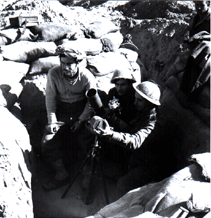
|
| On the morning of 16 October, a tank battalion of the 8th Armored Brigade, along with an infantry battalion of the 'Negev' Brigade, launched a major attack against El-Manshiyeh in an attempt to open the corridor to the south-east. This attempt failed and the force sufferred heavily. The following night, Givati units made a breakthrough west of Faluja, fighting their key battles at Hill 113 and nearby Egyptian strongholds known as the junction positions dominating the crossroads between Majdal and Faluja. After fierce hand-to-hand battle, Hills 113 and 100 were captured, and a day later the junction positions and Kaukaba were taken.
Knowing that the Security Council was anxiously trying to impose a cease-fire, Yigal Allon realized that he had little time to open the Negev road. He tasked the 'Givati' Brigade to attack the formidable Huleiqat defense system south on 19-20 October which was successful in capturing the complex and after bitter fighting the road to the Negev was open. At 4:00 on the morning of 21 October, the IDF moved to capture Beersheba. The force that moved on Beersheba consisted of major elements of the 8th Brigade, the commando battalion and two other battalions of the 'Negev' Brigade. While some units took up blocking positions north and south of the town to hold up Egyptian reinforcements, and another carried out a diversionary action in the direction of Hebron to the North. After fierce fighting, the 500-strong Egyptian garrison broke and, by 09:00 hrs that morning, Beersheba - capital of the Negev had surrendered to Israeli forces. The eastern part of the Egyptian Army was now cut into four isolated forces with brigades in: Rafah-Gaza; Majdal;Faluja (in which a brigade under the command of the Sudanese Brig. Gen. Taba Bey and whose operation officer Maj. Gamal Abdal Nasser was surrounded with all its main supply lines cut and two batallions in the region of Hebron-Jerusalem. The Israel Navy also took part in these southern actions, shelling enemy coastal installations, preventing supplies from reaching Gaza and Majdal by sea, and scoring an outstanding victory on the very eve of the truce when its special unit sank the Amir Faruq ("Emir Farouk"), flagship of the Egyptian navy, off the shores of Gaza. |
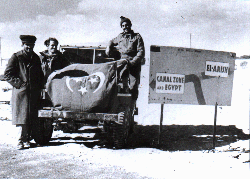
|
| The Harel Brigade played a major role during Operation Yoav. Mainly active in the mountainous area between the Jerusalem corridor and Bet Guvrin, widened the approaches to Jerusalem and cut the Egyptian artery from Bet Guvrin to Bethlehem. A truce was ordered for 15:00 hours on 22 October, but there was some action in the days immediately following. The Police fort of Bet Guvrin fell on 27 October, and after the Egyptians retreated southward from Ashdod (28 October) and Majdal (6 November) to Gaza, IDF troops occupied the coastal strip down to Yad Mordechai. On 9 November, the Iraq Suedan fortress was finally captured, after Israeli forces had failed to make it during previous attacks. Renamed Yoav Fortress in honor of this operation, it is today the site of the Givati Museum. |
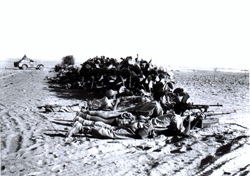
|
|
 |